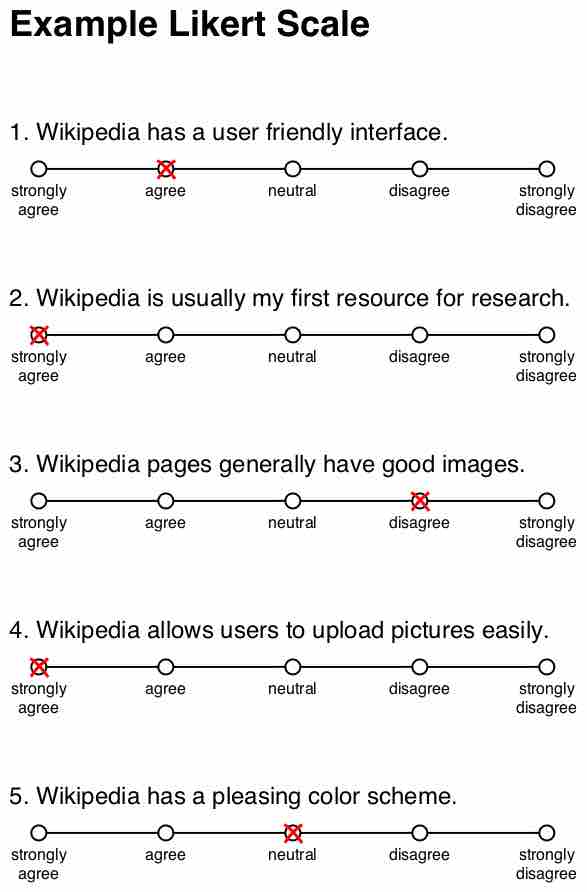Collecting Information about Your Particular Audience
So how do you go about collecting information about your particular audience? There are several useful methods to consider, including: (1) direct observation of members of the potential audience, and (2) data collection through interviews surveys and rating scales for opinions.
Direct Observation
Direct observation allows you to get to know the members of your audience personally. You are making observations of audience members through your own senses such as hearing, sight and perhaps smell. You can employ this method in a classroom or small group situation through conversations with others and by listening to what they say.
However, you will want to guard against introducing your own egocentric biases into the observation. Our human senses do not function like a video camcorder, impartially recording all observations. Thus two people can view the same audience and come away with entirely different perceptions of it, even disagreeing about simple facts. This is why eyewitness testimony is notoriously unreliable.
Interviews, Surveys and Rating Scales
INTERVIEWING
An interview is a conversation between two people--the interviewer and the interviewee --that involves asking questions to obtain information. Generally, you will be using the four different types of questions which follow:
- Open-ended questions. Questions that ask who, what, where, when, why, and how are generally good open-ended questions. An open-ended question requires the respondent to reply with more information than a "yes" or "no" answer. For example, "Tell me about what kind of music you listen to," will probably get you a lot more information than "Do you like to listen to death metal? " This will only require "yes" or "no. "
- Closed questions. When you need a "yes" or "no" answer or when you want the other person to provide you with a specific answer from among a set of choices, use closed questions. Closed means that you only have specific options, and no other choices. "Do you spend more time texting at home, work or school? " is a closed question with three choices.
- Probe for more information. After a respondent answers a question, you can probe to get clarification or more information. By asking "probing" questions you can tailor the interview, as it is occurring.
- Mirror questionsreflect the previous content back to the interviewee. A mirror question can be used to probe for more information or to provide a summary for the interviewee to agree, correct or expand upon.
Avoid leading questions. A leading question is one that virtually guarantees that the interviewee will reply with a desired answer. For example, "Wouldn't you prefer X? " indicates what you want the interviewee to prefer. You do not find out what the interviewee really thinks.
For large audiences you could use computer-assisted web interviewing (CAWI).
Questionnaires
The basic questionnaire is a survey consisting of a series of questions and other prompts for the purpose of gathering information from respondents. Questionnaires have advantages over other types of surveys in that they are cheap, do not require as much effort from the questioner as verbal or telephone surveys, and often have standardized answers that make it simple to compile data. For example, you might have a question with easy scorable multiple choice answers such as:
What is your marital status?
- Single
- Married
- Divorced
- Partnered
Likert-Type Testing of Attitudes and Opinions
Do you want to find out if members of the audience share the same attitudes or agree or disagree with your thesis? You can use a Likert-type rating scale of attitudes. A Likert item is simply a statement which the respondent is asked to evaluate according to any kind of subjective or objective criteria; generally the level of agreement or disagreement is measured. Often five ordered response levels are used. Look at the Likert Scale in the example , to see the format of the typical five-level Likert item which is:
- Strongly disagree
- Disagree
- Neither agree nor disagree
- Agree
- Strongly agree.
Tips for Speakers
Finally, when interviewing remember to allow the interviewee time to respond to your question without interrupting. Also, leave a few brief pauses between one question and the next so the interviewee can supply additional information. Or, probe before moving on to the next question. Usually you want to prepare a list of questions in advance and move from more general to specific questions.
When using a questionnaire or using rating scales it is wise to try them out on a small sample of your audience before you administer them to a large group. You can use the small sample to make sure that everyone understands the meaning of the questions and that you are getting useful information. You can collect the data directly or you can use computer-assisted web based surveys or interviewing questionnaires.

Lars G Nilsson interviews Thed Björk for Viasat Motor at Anderstorp Raceway in 2012, photo by Daniel Ahlqvist
Thed Björk interview 2012, photo was taken by Daniel Ahlqvist

Example Likert Scale Using Five Likert Items
Example of Likert Scale using five Likert Items pertaining to Wikipedia. by Nicholas Smith

Questionnaire
Visitors to the youth fair "YOU" filling out a questionnaire on Wikipedia. "© Raimond Spekking / CC-BY-SA-3.0 (via Wikimedia Commons)"